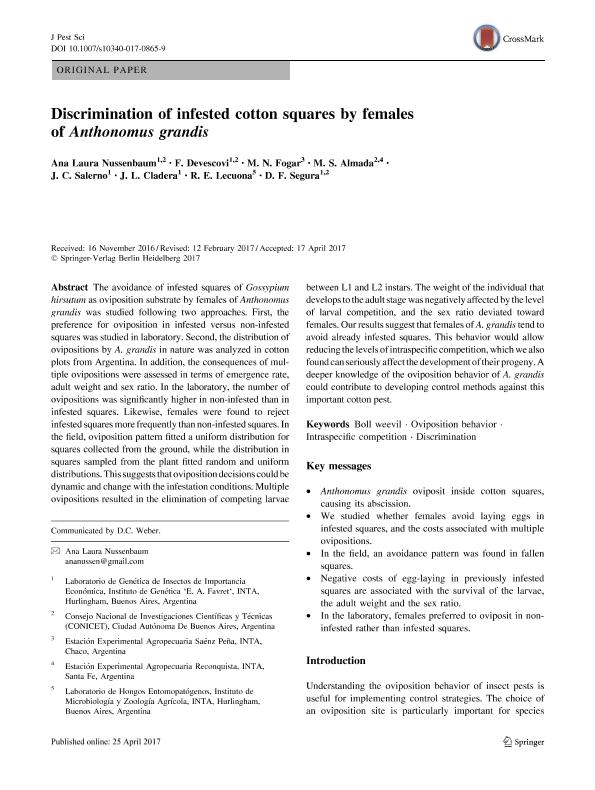Mostrar el registro sencillo del ítem
dc.contributor.author
Nussenbaum, Ana Laura

dc.contributor.author
Devescovi, Francisco

dc.contributor.author
Fogar, M. N.
dc.contributor.author
Almada, Melina Soledad

dc.contributor.author
Salerno, Juan Carlos

dc.contributor.author
Cladera, Jorge Luis

dc.contributor.author
Lecuona, Roberto Eduardo

dc.contributor.author
Segura, Diego Fernando

dc.date.available
2018-04-04T18:52:25Z
dc.date.issued
2017-04
dc.identifier.citation
Nussenbaum, Ana Laura; Devescovi, Francisco; Fogar, M. N.; Almada, Melina Soledad; Salerno, Juan Carlos; et al.; Discrimination of infested cotton squares by females of Anthonomus grandis Boheman (Coleoptera: Curculionidae); Springer Heidelberg; Journal of Pest Science; 91; 1; 4-2017; 107-119
dc.identifier.issn
1612-4758
dc.identifier.uri
http://hdl.handle.net/11336/40764
dc.description.abstract
The avoidance of infested squares of Gossypium hirsutum as oviposition substrate by females ofAnthonomus grandis was studied following two approaches. First, the preference for oviposition ininfested versus non-infested squares was studied in laboratory. Second, the distribution of ovipositions byA. grandis in nature was analyzed in cotton plots from Argentina. In addition, the consequences of multipleovipositions were assessed in terms of emergence rate, adult weight and sex ratio. In the laboratory, thenumber of ovipositions was significantly higher in non-infested than in infested squares. Likewise, femaleswere found to reject infested squares more frequently than non-infested squares. In the field, ovipositionpattern fitted a uniform distribution for squares collected from the ground, while the distribution in squaressampled from the plant fitted random and uniform distributions. This suggests that oviposition decisionscould be dynamic and change with the infestation conditions. Multiple ovipositions resulted in theelimination of competing larvae between L1 and L2 instars. The weight of the individual that develops tothe adult stage was negatively affected by the level of larval competition, and the sex ratio deviated towardfemales. Our results suggest that females of A. grandis tend to avoid already infested squares. Thisbehavior would allow reducing the levels of intraspecific competition, which we also found can seriouslyaffect the development of their progeny. A deeper knowledge of the oviposition behavior of A. grandiscould contribute to developing control methods against this important cotton pest
dc.format
application/pdf
dc.language.iso
eng
dc.publisher
Springer Heidelberg

dc.rights
info:eu-repo/semantics/openAccess
dc.rights.uri
https://creativecommons.org/licenses/by-nc-sa/2.5/ar/
dc.subject
Boll Weevil
dc.subject
Oviposition Behavior
dc.subject
Intraspecific Competition
dc.subject
Discrimination
dc.subject.classification
Otras Ciencias Biológicas

dc.subject.classification
Ciencias Biológicas

dc.subject.classification
CIENCIAS NATURALES Y EXACTAS

dc.title
Discrimination of infested cotton squares by females of Anthonomus grandis Boheman (Coleoptera: Curculionidae)
dc.type
info:eu-repo/semantics/article
dc.type
info:ar-repo/semantics/artículo
dc.type
info:eu-repo/semantics/publishedVersion
dc.date.updated
2018-04-04T14:15:32Z
dc.journal.volume
91
dc.journal.number
1
dc.journal.pagination
107-119
dc.journal.pais
Alemania

dc.description.fil
Fil: Nussenbaum, Ana Laura. Consejo Nacional de Investigaciones Científicas y Técnicas; Argentina. Instituto Nacional de Tecnología Agropecuaria. Centro de Investigación en Ciencias Veterinarias y Agronómicas. Instituto de Genética; Argentina
dc.description.fil
Fil: Devescovi, Francisco. Consejo Nacional de Investigaciones Científicas y Técnicas; Argentina. Instituto Nacional de Tecnología Agropecuaria. Centro de Investigación en Ciencias Veterinarias y Agronómicas. Instituto de Genética; Argentina
dc.description.fil
Fil: Fogar, M. N.. Instituto Nacional de Tecnología Agropecuaria; Argentina
dc.description.fil
Fil: Almada, Melina Soledad. Consejo Nacional de Investigaciones Científicas y Técnicas; Argentina. Instituto Nacional de Tecnología Agropecuaria. Centro Regional Santa Fe. Estación Experimental Agropecuaria Reconquista; Argentina
dc.description.fil
Fil: Salerno, Juan Carlos. Instituto Nacional de Tecnología Agropecuaria. Centro de Investigación en Ciencias Veterinarias y Agronómicas. Instituto de Genética; Argentina
dc.description.fil
Fil: Cladera, Jorge Luis. Instituto Nacional de Tecnología Agropecuaria. Centro de Investigación en Ciencias Veterinarias y Agronómicas. Instituto de Genética; Argentina
dc.description.fil
Fil: Lecuona, Roberto Eduardo. Instituto Nacional de Tecnología Agropecuaria. Centro de Investigación en Ciencias Veterinarias y Agronómicas. Instituto de Microbiología y Zoología Agrícola; Argentina
dc.description.fil
Fil: Segura, Diego Fernando. Consejo Nacional de Investigaciones Científicas y Técnicas; Argentina. Instituto Nacional de Tecnología Agropecuaria. Centro de Investigación en Ciencias Veterinarias y Agronómicas. Instituto de Genética; Argentina
dc.journal.title
Journal of Pest Science

dc.relation.alternativeid
info:eu-repo/semantics/altIdentifier/doi/http://dx.doi.org/10.1007/s10340-017-0865-9
dc.relation.alternativeid
info:eu-repo/semantics/altIdentifier/url/https://link.springer.com/article/10.1007%2Fs10340-017-0865-9
Archivos asociados
